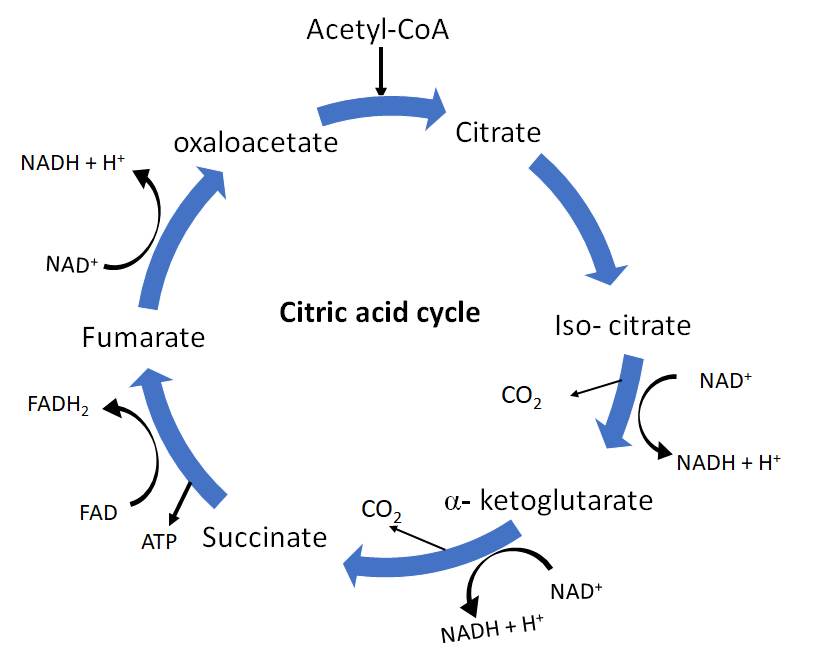
In one Krebs’ cycle, decarboxylation takes place at _______ steps.
(a) Five
(b) Four
(c) Three
(d) Two
Answer
478.5k+ views
Hint: Decarboxylation is the process of removal of the carboxyl group from a compound with the release of a carbon dioxide molecule. So, the number of steps in which a ${C}{O}_{2}$ molecule is released after removal of a carboxyl from a compound is the number of decarboxylation reactions in one Krebs’ cycle.
Complete answer:
Krebs’ cycle is the central pathway for the metabolism of carbohydrates, fats, and proteins. It begins with a citric acid molecule which is a 6- carbon compound and ends at Oxaloacetate which is a 4-carbon compound which indicates the removal of two carboxyl groups.
These carboxyl groups are removed with the release of a ${C}{O}_{2}$ molecule in two different steps.
- The first oxidative decarboxylation takes place at the fourth step of the TCA cycle where isocitrate is converted to 5-carbon α-ketoglutarate, with the release of a pair of hydrogen atoms and a molecule of carbon dioxide.
- The second oxidative decarboxylation occurs at the fifth step of the Krebs’ cycle where a molecule of coenzyme-A reacts with the α-ketoglutarate to form a 4-carbon compound succinyl- coenzyme A and releasing carbon dioxide and a pair of hydrogen atoms.

So, the answer is, “Two”.
Note:Decarboxylation is the reaction in which a carboxyl group is removed and it generally refers to the reactions of carboxylic acids. The reverse of this process in which there is an addition of a ${C}{O}_{2}$ molecule to a compound is called carboxylation and it is the first chemical step in photosynthesis.
Complete answer:
Krebs’ cycle is the central pathway for the metabolism of carbohydrates, fats, and proteins. It begins with a citric acid molecule which is a 6- carbon compound and ends at Oxaloacetate which is a 4-carbon compound which indicates the removal of two carboxyl groups.
These carboxyl groups are removed with the release of a ${C}{O}_{2}$ molecule in two different steps.
- The first oxidative decarboxylation takes place at the fourth step of the TCA cycle where isocitrate is converted to 5-carbon α-ketoglutarate, with the release of a pair of hydrogen atoms and a molecule of carbon dioxide.
- The second oxidative decarboxylation occurs at the fifth step of the Krebs’ cycle where a molecule of coenzyme-A reacts with the α-ketoglutarate to form a 4-carbon compound succinyl- coenzyme A and releasing carbon dioxide and a pair of hydrogen atoms.

So, the answer is, “Two”.
Note:Decarboxylation is the reaction in which a carboxyl group is removed and it generally refers to the reactions of carboxylic acids. The reverse of this process in which there is an addition of a ${C}{O}_{2}$ molecule to a compound is called carboxylation and it is the first chemical step in photosynthesis.
Recently Updated Pages
Can anyone list 10 advantages and disadvantages of friction

What are the Components of Financial System?

How do you arrange NH4 + BF3 H2O C2H2 in increasing class 11 chemistry CBSE

Is H mCT and q mCT the same thing If so which is more class 11 chemistry CBSE

What are the possible quantum number for the last outermost class 11 chemistry CBSE

Is C2 paramagnetic or diamagnetic class 11 chemistry CBSE

Trending doubts
The correct order of melting point of 14th group elements class 11 chemistry CBSE

One Metric ton is equal to kg A 10000 B 1000 C 100 class 11 physics CBSE

What is the specific heat capacity of ice water and class 11 physics CBSE

State the laws of reflection of light

The dimensional formula of dielectric strength A M1L1T2Q class 11 physics CBSE

The members of the Municipal Corporation are elected class 11 social science CBSE




